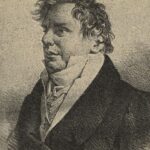In this article we cover the origins, the reception and interpretations of this controversial music.
The history of the Grosse Fuge
The history of Beethoven’s Grosse Fuge Op. 133 (in English the Great Fugue or Grand Fugue; in German Große Fuge, pronunciation ɡʁoːsə fuu·ge) starts with an other string quartet, his 13th, the Op. 130. The composer finished this work in 1825 as part of the Galitzin Quartets (commissioned by and named after the Russian prince Nikolai Borisovich Galitzin). The Grosse Fuge originally was the last, the sixth movement of Op. 130, making it approx. 45-50 minutes long piece. However, not the length was the biggest concern!
After the first performance of the Quartet both critics and audience were astonished, and not in a good way. The last movement horrified them! Beethoven did not attend the premiere in March 1826, he rather made himself comfortable at a tavern. Friends and colleagues brought him the news after, reporting that the middle movements were very well received, in fact the audience demanded a repeat. Beethoven was disappointed and furious, he said, “…and why didn’t they encore the Fugue? That alone should have been repeated! Cattle! Asses!”
Among the messengers was Karl Holz, second violinist in the Schuppanzigh quartet (they played the premiere) and confidant of Beethoven in his late years. He was entrusted by the publisher Artaria to convince Beethoven to make a new final movement for Op. 130 instead of this one, and make it a separate work under a new opus number.
Holz wrote,
“Artaria … charged me with the terrible and difficult task of convincing Beethoven to compose a new finale, which would be more accessible to the listeners as well as the instrumentalists, to substitute for the fugue which was so difficult to understand. I maintained to Beethoven that this fugue, which departed from the ordinary and surpassed even the last quartets in originality, should be published as a separate work and that it merited a designation as a separate opus. I communicated to him that Artaria was disposed to pay him a supplementary honorarium for the new finale. Beethoven told me he would reflect on it, but already on the next day I received a letter giving his agreement”
Ever since this Beethoven reply music enthusiasts debate why, the otherwise stubborn composer, had agreed to this solution. Some say, for financial reasons, but this is highly unlikely, given how perfectionist Beethoven was. Others argue that he himself had to feel the last movement is extreme for the contemporary taste, and was afraid it jeopardizes the future of the whole Quartet. Maybe, he accepted the idea that the last movement is so grandiose that it should live a life of its own.
The publisher Matthias Artaria later issued the Grosse Fuge as Op. 133 and a four-hand piano version as Op 134. Both after the death of Beethoven.
Today, the Opus 130 is often played with its original ending, the Grosse Fuge.
|Related: What is a fugue?
The reception of the Grosse Fuge
Since its first performance in 1826 this work is probably the most polarizing one from Beethoven.
Opinions on the Grosse Fuge from the last two hundred years:
“incomprehensible, like Chinese”,
“a confusion of Babel”,
“the most problematic single work in Beethoven’s output and … doubtless in the entire literature of music”,
“It will scarcely ever touch the heart.”,
“Impersonal, hostile objectivity.”,
“Its extraordinarily crabbed and cruel technical difficulties usually make it sound dry and dully ponderous in performance.”
“This fugue is one of the two works by Beethoven—the other being the fugue from the piano sonata, Op. 106—which should be excluded from performance.”
By Stravinsky: “The Great Fugue … now seems to me the most perfect miracle in music. It is also the most absolutely contemporary piece of music I know, and contemporary forever … Hardly birthmarked by its age, the Great Fugue is, in rhythm alone, more subtle than any music of my own century … I love it beyond everything.”
Glenn Gould said: “For me, the ‘Grosse Fuge’ is not only the greatest work Beethoven ever wrote but just about the most astonishing piece in musical literature.”
The above cited opinions clearly show how dividing this remarkable work is. One must add here, that the music is full with difficulties that greatly challenge the performers. Both technicalities and on interpretation.
Conclusion
Beethoven’s Grosse Fuge is a strange piece of music. It is forever avant-garde. Some consider it the product of a mad mind, some the greatest musical achievement of human imagination. Beethoven liked the Grosse Fuge and considered it as one of his greatest achievements. Easy listening or convenient playing was never the aim here. This is most evident from the story of the four-hands piano version.
The first version of the piano score was made by pianist Anselm Halm. When Beethoven received the arrangement there was a note, informing him that some modifications had to be done for the sake of convenience. Beethoven was having none of it! He rejected this version and made one himself (and got paid for it, again). Even for him the work was not easy, the original manuscript shows massive revisions, and even holes of erasures through the paper.
The silent hero in this story is the publisher Artaria, who after all paid for this music three times…





